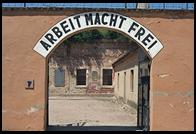
A visit to Terezin
by Chuck Vadun, part of Web Travel Review's Berlin/Prague story(photos by Philip Greenspun)
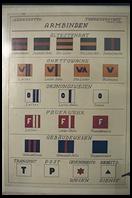

|
A visit to Terezinby Chuck Vadun, part of Web Travel Review's Berlin/Prague story(photos by Philip Greenspun) |

|
One of the many things that intrigued me about Terezin is that it had been used during the war as a facade: it was tarted up by the Nazis to look like a spa town to the International Red Cross. The ruse worked and the Red Cross backed off, allowing the death camps to continue their horrific work.
I started up a conversation with a pair of attractive young women who were also on the tour. Eileen and Jessica were students from the University of South Carolina who'd been studying in Germany. Eileen was a dual German/Music major, researching Terezin for her senior thesis.
We got on the bus around 9:45 for the hour-long journey north. Our guide introduced himself and began telling us the history of Terezin. Much of his story came from personal experience: he'd been a prisoner there, and had buried his own mother in one of Terezin's mass graves.
He noted that one of the goals of the Nazis was to "concentrate" the Jewish population in controlled locations, hence the term "concentration camp." Terezin wasn't an "extermination" camp like Auschwitz, though it served as a way station to the camps and ghettos in occupied Eastern Europe. However, that doesn't mean there weren't atrocities committed at Terezin; far from it, as we would soon discover.
In fact, of the nearly 140,000 men, women and children deported to Terezin from the Czech lands, Germany, Austria, the Netherlands, Denmark, Slovakia and Hungary, 34,000 died. From 1942 to 1944, transports carried 87,000 people from Terezin eastward; of those, 83,000 were murdered, tortured to death, or perished on forced marches.
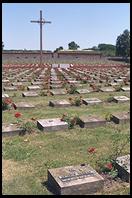
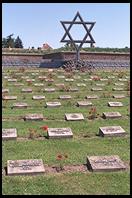 We visited Terezin's Small Fortress first; just outside the walls lay the
cemetery where thousands of political prisoners are buried. Our guide noted that
many of the dates on the tombstones were later than May 1945; many of Terezin's
prisoners were beyond medical help at the time of the camp's liberation by the
Russians, and died before they could be repatriated.
We visited Terezin's Small Fortress first; just outside the walls lay the
cemetery where thousands of political prisoners are buried. Our guide noted that
many of the dates on the tombstones were later than May 1945; many of Terezin's
prisoners were beyond medical help at the time of the camp's liberation by the
Russians, and died before they could be repatriated.
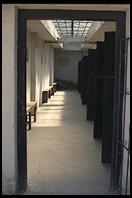
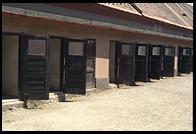 Our first stop once inside the walls was at a row of "isolation cells,"
rooms big enough to hold a pallet about the size of today's twin bed, and not
much else. It took me about three steps to walk the length of the cell. I did so
several times and tried to calculate how long it would have taken me to go crazy
in such a place.
Our first stop once inside the walls was at a row of "isolation cells,"
rooms big enough to hold a pallet about the size of today's twin bed, and not
much else. It took me about three steps to walk the length of the cell. I did so
several times and tried to calculate how long it would have taken me to go crazy
in such a place.
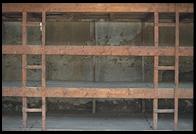 Next we saw some of the common rooms for women prisoners, perhaps the size
of a two-car garage, which held 25-30 people and provided no electricity or
running water.
Next we saw some of the common rooms for women prisoners, perhaps the size
of a two-car garage, which held 25-30 people and provided no electricity or
running water.
Brutal as they were, neither of these places prepared me for what came next: a room where the SS gave prisoners "extra treatment," as our guide put it. The most appalling example he told us was that the SS would lock 100 or so people in a space the size of your average suburban living room, without food or water-and simply wait for them all to die.
Around the corner was the shower room. Our guide must have seen our stunned expressions and read our minds: "These were actually showers, not gas chambers. In fact, one way that the inmates of Terezin found out about the gas chambers in the camps to the east was from a group of children who'd been shipped back to Terezin from Auschwitz. The children were to be deloused and began crying at the sight of the shower room, screaming, 'Gas! Gas!'"
We continued past the house where the camp commander and ranking guards lived to the target range. Prisoners would be forced to run from one side of the yard to the other, providing moving targets for the SS guards.
We walked through an opening in a high wall and the sight of a gallows knotted my insides. Our guide pointed out the two sets of steps resting on the platform of the gallows, upon which the condemned stood. He worked as a carpenter in the camp and had himself made the steps, not knowing their purpose.
Next came a "newer" section of the fortress, added during the war to house the growing number of prisoners. The common cells here actually provided electricity and running water at certain times of the day. The cells surrounded a courtyard where all the prisoners would be brought together on occasion. For example, our guide told us about the time three prisoners escaped from the camp. The prisoners were assembled in the courtyard and watched as three other prisoners were chosen and stoned to death. Later, when the surviving escapees were captured, the prisoners were reassembled and the escapees stoned to death as well.
 We left the Small Fortress and drove to the Large Fortress and the Terezin
ghetto. As we rode along the streets, I mentioned to Eileen and Jessica how
weird it would be to live in the town today, as over a thousand people do,
knowing the history of the place. On our way to the Jewish cemetery, we stopped
to look at the cavelike enclosures where Jews and Christians were given their
last rites before burial.
We left the Small Fortress and drove to the Large Fortress and the Terezin
ghetto. As we rode along the streets, I mentioned to Eileen and Jessica how
weird it would be to live in the town today, as over a thousand people do,
knowing the history of the place. On our way to the Jewish cemetery, we stopped
to look at the cavelike enclosures where Jews and Christians were given their
last rites before burial.
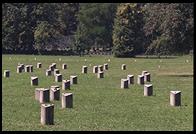 The rain had come and gone throughout the day, but as we got out of the bus
to walk to the Jewish cemetery, it began to come down in buckets. Our guide
explained that these were mass graves, and pointed out one monument that had
been placed there. I can paraphrase the inscription: "For those for whom it was
not possible to rest in their own land."
The rain had come and gone throughout the day, but as we got out of the bus
to walk to the Jewish cemetery, it began to come down in buckets. Our guide
explained that these were mass graves, and pointed out one monument that had
been placed there. I can paraphrase the inscription: "For those for whom it was
not possible to rest in their own land."
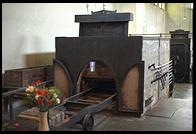 The climactic moment of the tour was a visit to the crematorium. A small
anteroom displayed prisoners' drawings of the crematorium, as well as Nazi
propaganda art praising the efficiency of the site and examples of records kept
at the camp. One of our group pointed out a meticulously-kept list of prisoners'
names and said, "This is why I can't understand why anyone can deny there was a
Holocaust. The Nazis wrote down everything."
The climactic moment of the tour was a visit to the crematorium. A small
anteroom displayed prisoners' drawings of the crematorium, as well as Nazi
propaganda art praising the efficiency of the site and examples of records kept
at the camp. One of our group pointed out a meticulously-kept list of prisoners'
names and said, "This is why I can't understand why anyone can deny there was a
Holocaust. The Nazis wrote down everything."
I could hear sheets of rain falling outside. Our guide ushered us into the crematorium itself with a sentence that ended in the word "death." As this word left his lips, a thunderclap struck outside and I didn't know whether to shake or jump-so I did both. An intensely scary moment.
We walked back to the bus and our guide said, "Now we will have lunch." Eileen and Jessica and I all looked at each other as if to say, "Yeah, right, we're really hungry now."
The three of us were joined by a pair of Swiss-German guys, Martin and Yves, on leave from military service. I felt like I wasn't ready to discuss any of the things we'd seen; I needed time to reflect on it. It turned out that we were all eager to lighten the mood a little, so we talked about life in Switzerland and Germany, South Carolina and San Diego. The women spoke good German, and Martin and Yves fairly good English, leaving yours truly as the only monolinguist in the crowd. My companions were gracious enough to translate anything said in German that made everyone laugh.
Our levity was short-lived, though; the next stop was the Jewish museum. We watched a film and saw displays chronicling the history of Terezin. But the most heart-wrenching exhibit was for me the collection of children's drawings. These were slices of life in Terezin as expressed as honestly as only a child could; each picture was noted with the child's name and whether or not they survived. Most didn't. An example: Daniel Stern, b. 1933, d. 1944 Osvetim (Auschwitz).
I'd kept my composure most of the day, but one of our guide's closing remarks on the way back to Prague caused me to lose it. He told us that we had a responsibility to tell our family and friends about what we had seen. As I was making a silent vow to remember everything I could and share what I'd learned with people back home, he said: "Even after all I have experienced, I cannot hate." My throat tightened and tears welled up in my eyes and spilled down my cheeks.
Visiting a concentration camp is not an enjoyable experience, yet I believe it is an intensely valuable one. It provides you with a focal point for everything you've seen in films and read in books about the Holocaust. It also helps you to view events in your own life with a new perspective: as a copywriter and graphic designer, I'll never look at the "life-and-death" arguments we have about grammatical correctness and font size the same way again.
If you visit Prague, tear yourself away from that beautiful city to spend a day in Terezin. As the woman who signed the Jewish museum's guest book ahead of me wrote, "We must never forget."
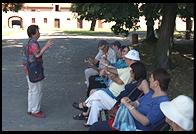 My guide was Irena Ravel, a survivor of Theresienstadt who was
imprisoned there at the age of 17 and emigrated to Israel after the war.
We are among the last generation who will be guided through the Nazi
concentration camps by those who lived through them. It will be very
easy to forget or distort the entire period once all those who lived
through it are gone. Ms. Ravel had many interesting stories about
Theresienstadt, some of which related to acquaintances who survived the
entire war and then committed suicide upon returning to their villages.
Running from the Germans gave shape to their lives. Returning to find
no family, no job, no money, someone else living in their house, etc.,
is what finally broke their spirit. These stories underscored the
paramount importance of the new State of Israel for postwar Jewish
refugees.
My guide was Irena Ravel, a survivor of Theresienstadt who was
imprisoned there at the age of 17 and emigrated to Israel after the war.
We are among the last generation who will be guided through the Nazi
concentration camps by those who lived through them. It will be very
easy to forget or distort the entire period once all those who lived
through it are gone. Ms. Ravel had many interesting stories about
Theresienstadt, some of which related to acquaintances who survived the
entire war and then committed suicide upon returning to their villages.
Running from the Germans gave shape to their lives. Returning to find
no family, no job, no money, someone else living in their house, etc.,
is what finally broke their spirit. These stories underscored the
paramount importance of the new State of Israel for postwar Jewish
refugees.
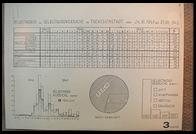 Suicide within Theresienstadt was a carefully studied subject for the
minor German bureaucrats who ran the town/prison. The chart at right
shows suicides and attempted suicides.
Suicide within Theresienstadt was a carefully studied subject for the
minor German bureaucrats who ran the town/prison. The chart at right
shows suicides and attempted suicides.
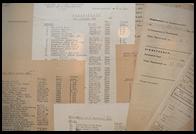
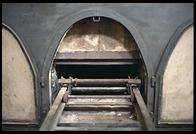
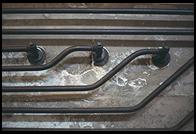
Near Hamburg, a labor camp was set up (perhaps with Biblical irony) to make bricks for the rebuilding of Hamburg according to A. Speer. Now KZ Gedenkstaette-Neuengammen (easily reached from Hamburg by car or public transport) is an educational center of considerable size and scope.Nancy Alkire (alkire@ucsub.colorado.edu)When I was an exchange student in Germany 16 years ago, this site was an empty set of fields and weeds covering concrete and rusting iron. Now educational signs have been put in, many of the buildings have been reconstructed and an exhibit hall built.
I've not been to any other KZ site, but I can say that I was struck by the size and contents of the site: there was a canal, rail road spur, and rows of concrete barbed wire supports all original to the camp. These are shown in pictures on large placards with texts explaining the works and companies involved. Reconstructions of several buildings have been made. A set of walks takes you through the site; it is horrifyingly large.
Approximately 55,000 died at Neuengammen. I highly recommend a visit.
As a baby survivor of Terezin I still have to pinch myself that I survived over 2 years in that horrible place
-- jackie Young, October 3, 2009